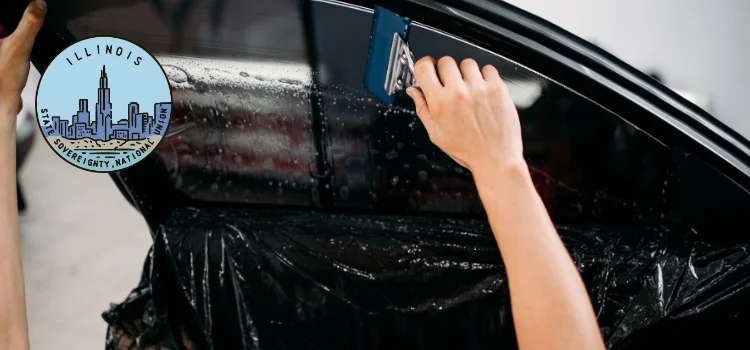Table of Contents
Window tinting can be a great way to enhance the appearance of your vehicle while also providing several benefits such as privacy and protection from harmful UV rays. However, it is important to ensure that the window tint you apply complies with the legal requirements in your state. In Illinois, there are specific regulations regarding the darkness and reflectivity of window tint, and failure to adhere to these guidelines can result in fines or even the removal of the tint. In this article, we will guide you through the process of applying legal window tint in Illinois, so you can enjoy the benefits without any legal repercussions.
1 Understanding Illinois Window Tint Laws

Before diving into the application process, it is crucial to familiarize yourself with the window tint laws in Illinois. The regulations specify the maximum allowable darkness and reflectivity levels for different windows of a vehicle. Here are the key points you need to know:
- Front Side Windows: The tint on the front side windows must allow at least 35% of light to pass through. This requirement ensures that the driver has clear visibility and that law enforcement officers can easily see into the vehicle.
- Rear Side Windows: The tint on the rear side windows can have any darkness level. This flexibility allows vehicle owners to choose the level of privacy they desire for the rear passengers.
- Rear Window: The tint on the rear window can have any darkness level. This regulation also gives vehicle owners the freedom to decide the darkness level based on their preferences.
- Windshield: Non-reflective tint is allowed on the top 6 inches of the windshield. This provision helps reduce glare from the sun while ensuring that the driver’s view is not obstructed.
To avoid any legal issues, it’s essential to ensure that your window tint complies with these regulations.
2 Choosing the Right Window Tint

Now that you are familiar with the legal requirements, it’s time to choose the right window tint for your vehicle. Here are a few factors to consider:
- Darkness Level: Select a tint that meets the darkness requirement for front side windows, which is 35% light transmittance. The darkness level affects the amount of light that passes through the tint and into the vehicle. It is important to strike a balance between privacy and visibility.
- Quality: Opt for high-quality window tint that offers good heat and UV ray rejection properties. A high-quality tint can provide better protection against harmful UV rays, reduce heat buildup inside the vehicle, and improve overall comfort.
- Brand Reputation: Research different window tint brands and choose a reputable one known for its durability and adherence to legal standards. A trusted brand is more likely to provide reliable and long-lasting window tint.
- Professional Installation: While you can install window tint yourself, it is recommended to seek professional installation services to ensure a flawless and long-lasting result. Professional installers have the expertise and tools to apply the tint evenly and without any imperfections.
By considering these factors, you can choose a window tint that not only complies with the legal requirements but also meets your specific needs and preferences.
3 The Process of Applying Window Tint

Once you have chosen the appropriate window tint, follow these steps to apply it correctly:
- Gather the Required Materials: Before starting the application process, gather all the necessary materials. You will need window tint film, a spray bottle filled with soapy water, a squeegee, a razor blade or window film cutting tool, a heat gun or hairdryer, and a lint-free cloth or microfiber towel. Having all the materials ready will ensure a smooth application process.
- Clean the Windows: Thoroughly clean the windows using a mild detergent to remove any dirt, dust, or debris. This step is crucial as it ensures a smooth application and helps prevent any imperfections or bubbles in the tint.
- Measure and Cut the Tint Film: Measure the dimensions of each window and use a razor blade or window film cutting tool to cut the tint film accordingly. It is advisable to cut the film slightly larger than the window size to allow for adjustments during the installation process. This extra margin ensures that the entire window is covered and allows for precise trimming later on.
- Prepare the Tint Film: Lay the cut pieces of tint film on a clean, flat surface with the adhesive side facing up. Spray the adhesive side generously with the soapy water solution to prevent it from sticking during application. This step helps make the tint film easier to handle and maneuver into the correct position on the window.
- Apply the Tint Film: Carefully position the tint film on the inside of the window, starting from the top. Use your hands or a squeegee to press the film against the window, removing any air bubbles or wrinkles as you go. Take your time during this step to ensure a smooth and even application.
- Trim and Shape the Film: Use a razor blade or window film-cutting tool to trim off any excess film around the edges of the window. Ensure that the film fits perfectly within the window frame. Trimming the film precisely gives your windows a polished and professional look.
- Smooth Out Wrinkles and Bubbles: With the help of a heat gun or hairdryer, gently heat the tint film to make it more pliable. This heat softens the film, making it easier to smooth out any remaining wrinkles or bubbles. Use the squeegee to press out any imperfections, working from the center towards the edges.
- Clean and Dry the Tinted Windows: Once the installation is complete, clean the tinted windows with a lint-free cloth or microfiber towel to remove any residual moisture or dirt. This final step ensures that your windows are clean and clear, providing you with a flawless and professional-looking finish.
4 Maintaining Your Window Tint
To prolong the lifespan and appearance of your window tint, follow these maintenance tips:
- Avoid Cleaning for a Few Days: Allow the tint film to fully cure before cleaning the windows. Typically, it takes around 2 to 3 days for the tint to dry completely. Cleaning the windows too soon can disrupt the adhesive bond and potentially damage the tint.
- Use Non-Abrasive Cleaning Products: When cleaning the tinted windows, use non-abrasive cleaning solutions and a soft cloth or sponge to avoid scratching the film. Abrasive products can cause scratches and damage the tint, affecting its longevity.
- Avoid Harsh Window Cleaners: Steer clear of ammonia-based or abrasive window cleaners, as they can damage the tint film over time. Opt for mild and tint-safe cleaning solutions to maintain the pristine condition of your window tint.
- Be Gentle While Rolling the Windows: While the tint film adheres firmly to the glass, it is advisable to be cautious when rolling the windows up or down. Applying excessive force may cause the tint film to peel or bubble. Handle the windows gently to prevent any damage to the tint.
- Regular Inspections: Periodically inspect your window tint for any signs of damage, such as scratches or peeling. Address any issues promptly to prevent further damage or non-compliance with legal regulations. Prompt repairs or replacements can help maintain the integrity of your tint and ensure it continues to meet legal requirements.
By following these guidelines, you can confidently apply legal window tint to your vehicle in Illinois. Remember to always ensure compliance with the state laws and consider seeking professional installation services for the best results. Enjoy the benefits of privacy, UV protection, and enhanced aesthetics that window tinting provides!
5 FAQ
1. What are the regulations for window tint in Illinois?
- Front Side Windows: The tint on the front side windows must allow at least 35% of light to pass through.
- Rear Side Windows: The tint on the rear side windows can have any darkness level.
- Rear Window: The tint on the rear window can have any darkness level.
- Windshield: Non-reflective tint is allowed on the top 6 inches of the windshield.
2. What factors should I consider when choosing window tint?
- Darkness Level: Choose a tint that meets the 35% light transmittance requirement for front side windows.
- Quality: Opt for high-quality window tint that offers good heat and UV ray rejection properties.
- Brand Reputation: Research different window tint brands and choose a reputable one known for durability and adherence to legal standards.
- Professional Installation: Consider seeking professional installation services for a flawless and long-lasting result.
3. What is the process for applying window tint?
- Gather the Required Materials
- Clean the Windows
- Measure and Cut the Tint Film
- Prepare the Tint Film
- Apply the Tint Film
- Trim and Shape the Film
- Smooth Out Wrinkles and Bubbles
- Clean and Dry the Tinted Windows
4. How do I maintain my window tint?
- Avoid Cleaning for a Few Days after installation to allow the tint film to fully cure.
- Use Non-Abrasive Cleaning Products and a soft cloth or sponge when cleaning the tinted windows.
- Avoid Harsh Window Cleaners, such as ammonia-based or abrasive cleaners.
- Be Gentle While Rolling the Windows to prevent peeling or bubbling of the tint film.
- Regularly Inspect the window tint for any signs of damage and address any issues promptly.














